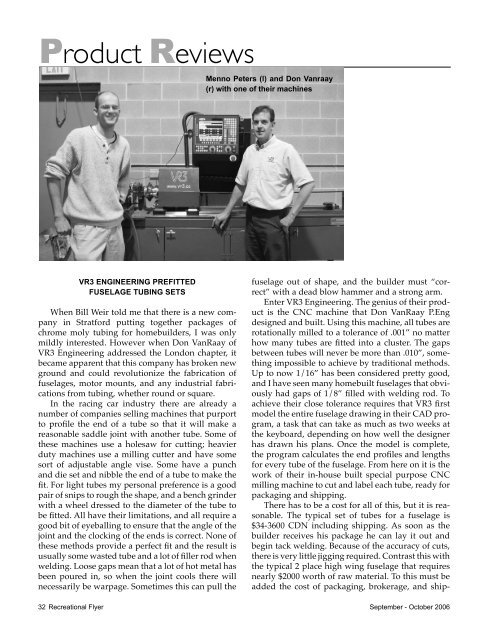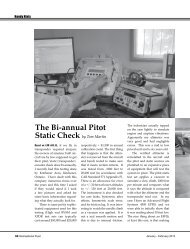September - October - The Recreational Aircraft Association
September - October - The Recreational Aircraft Association
September - October - The Recreational Aircraft Association
Create successful ePaper yourself
Turn your PDF publications into a flip-book with our unique Google optimized e-Paper software.
Product Reviews<br />
VR3 ENGINEERING PREFITTED<br />
FUSELAGE TUBING SETS<br />
When Bill Weir told me that there is a new company<br />
in Stratford putting together packages of<br />
chrome moly tubing for homebuilders, I was only<br />
mildly interested. However when Don VanRaay of<br />
VR3 Engineering addressed the London chapter, it<br />
became apparent that this company has broken new<br />
ground and could revolutionize the fabrication of<br />
fuselages, motor mounts, and any industrial fabrications<br />
from tubing, whether round or square.<br />
In the racing car industry there are already a<br />
number of companies selling machines that purport<br />
to profile the end of a tube so that it will make a<br />
reasonable saddle joint with another tube. Some of<br />
these machines use a holesaw for cutting; heavier<br />
duty machines use a milling cutter and have some<br />
sort of adjustable angle vise. Some have a punch<br />
and die set and nibble the end of a tube to make the<br />
fit. For light tubes my personal preference is a good<br />
pair of snips to rough the shape, and a bench grinder<br />
with a wheel dressed to the diameter of the tube to<br />
be fitted. All have their limitations, and all require a<br />
good bit of eyeballing to ensure that the angle of the<br />
joint and the clocking of the ends is correct. None of<br />
these methods provide a perfect fit and the result is<br />
usually some wasted tube and a lot of filler rod when<br />
welding. Loose gaps mean that a lot of hot metal has<br />
been poured in, so when the joint cools there will<br />
necessarily be warpage. Sometimes this can pull the<br />
Menno Peters (l) and Don Vanraay<br />
(r) with one of their machines<br />
fuselage out of shape, and the builder must “correct”<br />
with a dead blow hammer and a strong arm.<br />
Enter VR3 Engineering. <strong>The</strong> genius of their product<br />
is the CNC machine that Don VanRaay P.Eng<br />
designed and built. Using this machine, all tubes are<br />
rotationally milled to a tolerance of .001” no matter<br />
how many tubes are fitted into a cluster. <strong>The</strong> gaps<br />
between tubes will never be more than .010”, something<br />
impossible to achieve by traditional methods.<br />
Up to now 1/16” has been considered pretty good,<br />
and I have seen many homebuilt fuselages that obviously<br />
had gaps of 1/8” filled with welding rod. To<br />
achieve their close tolerance requires that VR3 first<br />
model the entire fuselage drawing in their CAD program,<br />
a task that can take as much as two weeks at<br />
the keyboard, depending on how well the designer<br />
has drawn his plans. Once the model is complete,<br />
the program calculates the end profiles and lengths<br />
for every tube of the fuselage. From here on it is the<br />
work of their in-house built special purpose CNC<br />
milling machine to cut and label each tube, ready for<br />
packaging and shipping.<br />
<strong>The</strong>re has to be a cost for all of this, but it is reasonable.<br />
<strong>The</strong> typical set of tubes for a fuselage is<br />
$34-3600 CDN including shipping. As soon as the<br />
builder receives his package he can lay it out and<br />
begin tack welding. Because of the accuracy of cuts,<br />
there is very little jigging required. Contrast this with<br />
the typical 2 place high wing fuselage that requires<br />
nearly $2000 worth of raw material. To this must be<br />
added the cost of packaging, brokerage, and ship-<br />
32 <strong>Recreational</strong> Flyer <strong>September</strong> - <strong>October</strong> 2006




